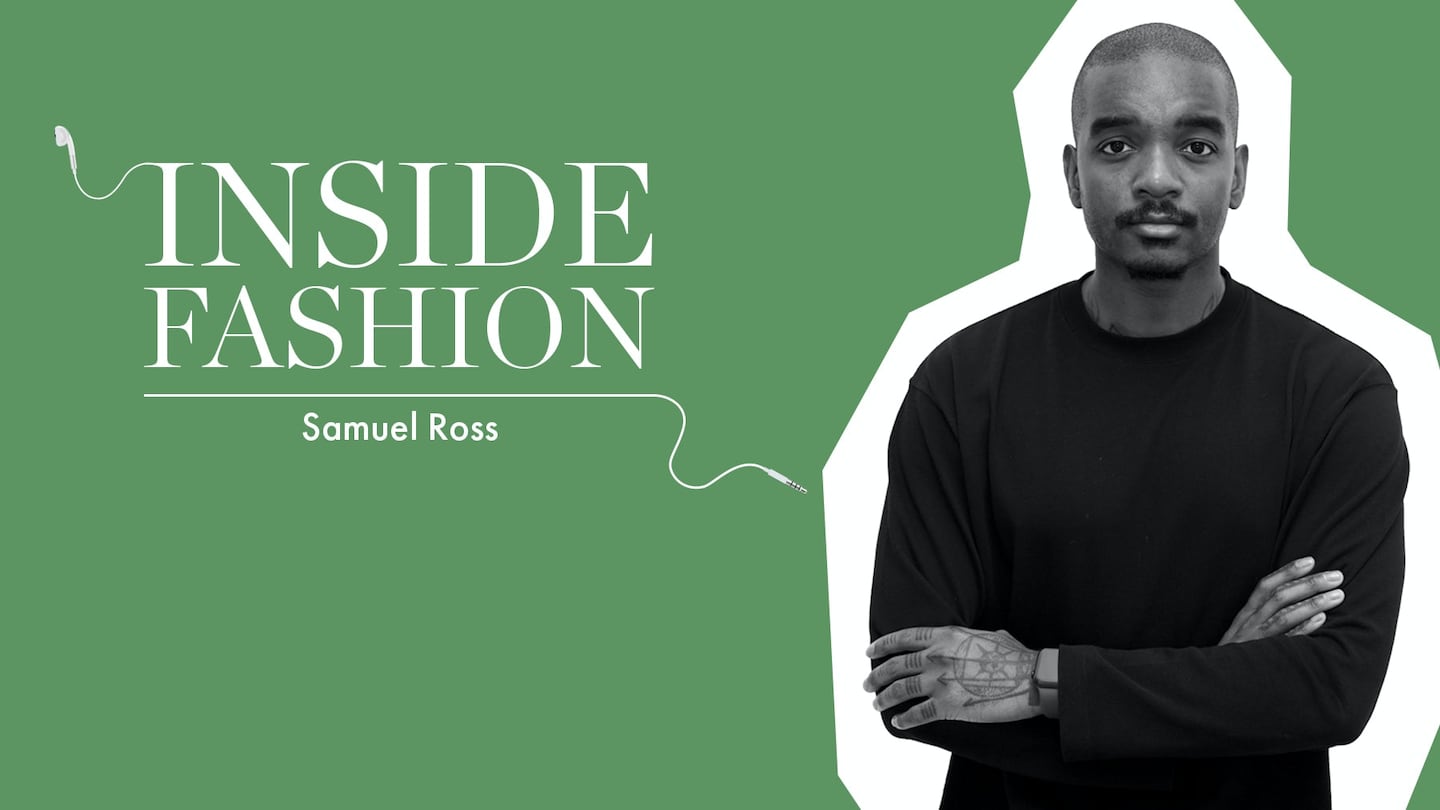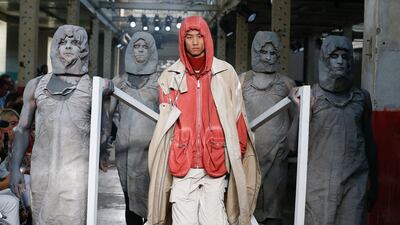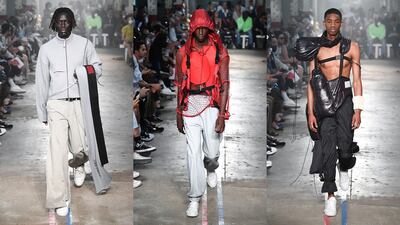
The Business of Fashion
Agenda-setting intelligence, analysis and advice for the global fashion community.

Agenda-setting intelligence, analysis and advice for the global fashion community.

To subscribe to the BoF Podcast, please follow this link.
LONDON, United Kingdom — The menswear scene in London boasts a triumvirate that is unique in the contemporary fashion world for its creativity, its originality and its engagement with social issues. Yet, the seeds this trio sow are scattered wide this season. Grace Wales Bonner showed in her hometown, but Craig Green will front up in Paris while Samuel Ross presents his latest collection for A-Cold-Wall in Milan today.
Ross' move to Milan stems from conversations he had with GQ editor Dylan Jones and the British Fashion Council's Caroline Rush after he won the BFC/GQ Menswear Fund award last June. As he laid out his plans for ACW's future with them and his business partner Stefano Martinetto, CEO of the fashion group Tomorrow London, it became obvious that, with the no-longer-fledgling brand turning five, it was time for a new chapter. With Martinetto's connections, Milan was an ideal launchpad. And Ross took little persuading. For him, Milan signified maturity, refinement and the best possible showcase for his label's next step.
In the past, Ross has compared ACW’s evolution to a boy-to-man transition. He figures the Milan move places him somewhere in his mid-teens. “Milan is a new landscape, it's a new audience and demographics, and the expectation of the clothes is completely different,” he says. It’s a liberating move, he adds, his next professional step coinciding with a moment of personal rebirth. “I've never felt this aligned with the work I've put forth out of A-Cold-Wall. Now, I'm at a point where structurally we have a brilliant team in place. I'm able to articulate myself correctly, understanding more the rules and laws of menswear and how people wish to express themselves with garments. It's no longer solely based on myself and the pursuit of self-expression as an artistic endeavour.”
ADVERTISEMENT
He's playing the game on a different level.
Listen to how he defines what he does: “Sophisticated menswear which speaks to a younger generation and almost forms a bridge point between streetwear and high fashion with a different slant than we’ve seen.” It’s a formula that hit hard and fast with hypebeast fanboys. When I first spoke to Ross a couple of seasons ago, I was struck by his enthusiastic facility with numbers. It sounded like he was doing seven figures in revenue right out of the gate. Now, he’s a more mature 28 years old. His tone’s more relaxed, the clothes more sophisticated. He’s playing the game on a different level.
It’s as if Ross has willingly placed himself inside the box, after five diligent years on the outside. Remember that ACW started as a 2000-word dissertation. It was an ideology before it was a brand and, if such a notion sounds pretentious, that only meant it was a perfect match for Ross’ own fearlessly serious philosophising. Though he'll manifesto like a baby Karl Marx — and his inspiration for ACW is rooted in the tribes of the British class system — he seems newly capable of the odd gust of laughter.
Still, he is definitely his parents’ child. His mother is a sociologist and psychology lecturer at Northampton University and his father was, according to Ross, “a neo-Christian, leftist pastor in Marxist Brixton in the late '80s.” You can ferret him out on Wikipedia as a philosophical mystic who had a life-changing influence on the spiritual teacher Mooji, loved by millions online. He also has a degree in fine arts from Central Saint Martins as a stained-glass artist, and an MA in industrial design. So, Ross grew up in a very particular environment. His parents compounded their value system by home-schooling him for years. It’s no coincidence that a word Ross returns to all the time when he’s talking about his own work is “altruism.” A commitment to serving society has infused everything he has ever done.

A-Cold-Wall Spring/Summer 2019 | Source: Courtesy
His own background was graphic art and product design. "Dieter Rams, Braun, system-based. I was in product design for about a year-and-a-half, two years. I was designing fridge components and pots and pans. Very literal housewares, as well as manuals and types of graphic systems and whatnot." Given that mentor Virgil Abloh was also a Rams fan, it's easy to see why the founder of Off-White would identify Ross as a kindred spirit when he came across him on Instagram. "There were already nuances and codes in how I would communicate my work online as a product designer or graphic designer with which Virgil could immediately resonate," Ross says. "Similar ways in which creative individuals put their selves forth into the market." Their digital connection turned into a working relationship, then a big-brother-younger-brother friendship, rooted in a shared work ethic and ambition, as well as creative resonance.
Through Abloh, Ross spent his early 20s working for Donda, the creative agency that Kanye West founded and named after his mother in 2012. I can't help wondering what kind of insight into the madness of fame a young mind would glean from such an experience. "I remember the first time, meeting both of them. It was in Paris and it was the second Kanye/APC presentation. I was tying up the laces for all of the Timberland boots. You get your hands dirty and do what you can, as you should do when you're trying to make your way in an industry. I think it was more about being transported into this different universe… It was like this moment of a part of your mind opening up and becoming conscious of how powerful one's will can be and where that willpower can take one. It was a real revelation."
It was this idea of extending the life-cycle of one product which, of course, counters the whole philosophy of sneaker culture…the over-consumption, to be blunt, within streetwear.
I think of Abloh as being quite profligate, throwing so much against the wall that some of it is inevitably going to stick, whereas Ross is all about intensity of focus. When you do a lot with a little, you make a much bigger impression than when you do a little with a lot. “Indeed,” Ross agrees, “because you must harness and intensify the resources or the challenge… it's ensuring that only essential information and products and goods and artefacts and articles are left behind and put forth.”
It’s actually the way he lives his own life. Ross says he edited 450 products out of his home over the Christmas holidays: books, sneakers, stuff… His Marie Kondo moment was inspired by the appetite for minimalism embraced by Tokyo in the wake of the Tōhoku earthquake, tsunami and subsequent nuclear disaster in 2011. “This idea of having only what is essential and only what is necessary resonated, but also it just felt very honest and, of course, it goes back to this idea of functional design.” ACW’s last collection had 280 SKUs. In the days before his forthcoming Milan debut, his latest collection is down to 140 SKUs and his team is still editing. “They're only putting forth what is essential and what is incredibly well-made, versus the pursuit of simply expressing one's opinion.”
ADVERTISEMENT
This is ultimately the ACW take on "less is more," but a cursory scan of the collection also makes me think of Karl Lagerfeld's old adage that it's better to have one beautiful object than a hundred mediocrities. The suit in Yves Klein blue with a crispy taffeta hand? God only knows what it's made of but it's opulent! And this single ultra-refined item (there are many in the collection) crystallises Abloh's recent declaration that streetwear is on the fade, taking with it the compulsive consumerism of The Drop.
Ross claims he’s been battling with the idea for the last 18 months, since his second Nike release, the ACW Vomero sneaker. “The compromise was to have a sneaker which ages and develops over time due to creating patinas in different levels of UV coatings across different panels on the sneaker. It was this idea of extending the life-cycle of one product which, of course, counters the whole philosophy of sneaker culture…the over-consumption, to be blunt, within streetwear… an incorrect value system that I don't really agree with.”
I feel like I'm really telling my truth now, and I haven't felt like that since the first or second year of A-Cold-Wall.
If the Vomero was his first step away from excess, Ross says his presentation during the men’s shows in London made his feelings even more obvious. He turned a huge concrete bunker into a rubber-floored, temple-like space (set of Aliens, I thought) where he hung seven iterations of the M-1965, a field jacket created for the American military during the Vietnam War. It’s a piece of clothing that is so anonymous in its familiarity that it offered Ross a perfect blank canvas, now known simply as the M-65, on which to write a new message. The versions he created using seven deadstock fabrics from classic Italian mills (Maiocchi, Limonta, Olmetex) were dramatically different. He applied a UV-sensitive film to the beige coat which would turn a rich navy in UV light. Underneath the maroon lacquer on another M-65, there was a matte black finish which would peel over time to create a fragile patina. “It was almost as though the agenda was to create a time-lapse to show how the M-65 can evolve and how it can live,” explains Ross. “On the other hand, it was just an amazing opportunity to showcase the level of study that's going into our pattern-cutting and pattern-making.”

A-Cold-Wall Menswear Spring/Summer 2019 | Source: InDigital
Over recent seasons, we’ve grown accustomed to fashion’s efforts to make the ordinary seem extraordinary. Ross’ own wrinkle might be the incredibly detailed technical booklet he provided with each M-65, so complex that it was the next best blueprint to building your own jet fighter. In its coolly distilled nuts-and-bolts-dom, it was the perverse antithesis of fashion’s appeal to the emotions. Or was it? “It's the easiest way for me to process information myself,” Ross says. “It's almost sharing an element of my own learning process and mirroring that to individuals, to consumers, to the market itself.”
The booklet took him a good two or three days to write, and a lot of green tea at 3am. “It was this idea of, I'm not going to actually speak about this, I'm just going to write this and let people delve into it themselves. The way it hung on the front of the garment was almost like a proposition. Like red pill, blue pill. You can sit here and enjoy the jacket, or you can really get into it and understand why.”
Red pill, blue pill… couldn’t have put it better. Until now, ACW has been most alive as a challenge to fashion orthodoxy. It’s even had a little of the look of The Matrix. But the operatic sturm-und-drang staging of Ross’ Autumn/Winter 2019 show — exhausted figures hauling themselves through dark water towards a life-saving raft while guard dogs barked — was a turning point. Too heavy, he concluded. The clothes were the best ACW had made, but they weren’t necessarily communicated in the best way.
His work speaks for him. And what it's saying, starting with the Milan collection, is that Ross is softening.
Significantly, the Milan show is untitled. The drama will be dialled down. I always thought the very name A-Cold-Wall, with the tricky little asterisk in its fully-branded incarnation (A-COLD-WALL*) was forbidding, chilly and elitist. It sounded more like a revolutionary cell than a label helmed by an individual. I was curious as to whether Ross deliberately cultivated that anonymity. “It was really about understanding my experience,” he replies. “Not my own actually, but one of the demographic — and being able to hold this mirror and refract, reflect even, what people have experienced. It wasn't exclusive to myself. It always comes back to this idea of understanding that you are within a wider ecosystem. One's experience is often shared or should be shared… it's always been about that communal spirit.”
ADVERTISEMENT
Ross’ thoughts can often come across as convoluted; they need to be distilled down into something much snappier, in the same way that “altruism” registers much more immediately with people when you call it “compassion.” But ultimately it comes back to that old cliché: his work speaks for him. And what it’s saying, starting with the Milan collection, is that Ross is softening. He’s a father now. The cold wall is warming. “100 percent,” he agrees. “Sometimes I think, ‘Oh, this is such a corrosive name.’” Ross launched the M-65 project under the name Service Point 1 because he thought it sounded a bit more “human.” It marks a watershed moment for him: ego vs. product. Artist vs. designer.
For all that, his huge ambition is undiminished. His dream is turning his brand into an “entity” that transcends mere product. “It's almost like you can have Dell and then you can have Apple,” Ross explains. “One is a brand and service, and one is an entity which has a philosophy and persona… I was incredibly interested in this idea of entity and community existing alongside random product.”
His dream is turning his brand into an "entity" that transcends mere product.
In September, Ross won the Hublot Design Award at the Serpentine Gallery for "this refuge point I developed, which was to be placed in public spaces as a point of emergency for those in need." He developed an anti-fungal blanket from recycled polyester and plastic bottles woven into a thread with aluminium, which acted as both protectant and cleanser. "It's fabric-related, but not fashion-related," says Ross. "It's public service and industrial design coming forth."
“Allegiance to a greater cause,” he calls it. “I feel just as passionate about those endeavours as I do when I'm creating a collection and putting forth that proposal.” Ross reminds me of mentor Abloh with this widescreen outreach in the way that he initially fired in all directions with ACW offshoots. But his sense of focus is tighter, manifest now in his deliberate pruning of the extracurriculars. His sideline Concrete Objects is gone, subsumed into Samuel Ross & Associates. Polythene Optics, ACW’s discreet sister brand, stays for the moment. “But right now, we’re purging and allowing a lot of noise to fall away from my process… focusing on what is and what is not necessary.”
“I feel like I'm really telling my truth now, and I haven't felt like that since the first or second year of A-Cold-Wall,” adds Ross, looking ahead. “In ten years, it looks like systems of garment design, it looks like language and it looks like communication… I believe fashion is always going to be a macro form of communication,” he continues. “It's one of the most intelligible and emotional ways to speak to people. I'm definitely invested in communicating through a garment.”
There’s more.
“The sense of being a spiritual being has become more and more relevant as my daughter grows and as me and my fiancée begin to move on to the next phases in life, but also this amalgamation between what is truly important to an individual and how entity and brand can interact and become cohesive within that dialogue. More organic notions are starting to make a lot of sense. The more macabre and dystopian and corrosive elements are almost falling away.” The cold wall is melting.
To contact The Business of Fashion with comments, questions, or speaker ideas please e-mail podcast@businessoffashion.com.
The Swiss watch sector’s slide appears to be more pronounced than the wider luxury slowdown, but industry insiders and analysts urge perspective.
The LVMH-linked firm is betting its $545 million stake in the Italian shoemaker will yield the double-digit returns private equity typically seeks.
The Coach owner’s results will provide another opportunity to stick up for its acquisition of rival Capri. And the Met Gala will do its best to ignore the TikTok ban and labour strife at Conde Nast.
The former CFDA president sat down with BoF founder and editor-in-chief Imran Amed to discuss his remarkable life and career and how big business has changed the fashion industry.